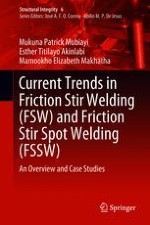This book provides an overview of friction stir welding and friction stir spot welding with a focus on aluminium to aluminium and aluminium to copper. It also discusses experimental results for friction stir spot welding between aluminium and copper, offering a good foundation for researchers wishing to conduct more investigations on FSSW Al/Cu. Presenting full methodologies for manufacturing and case studies on FSSW Al/Cu, which can be duplicated and used for industrial purposes, it also provides a starting point for researchers and experts in the field to investigate the FSSW process in detail. A variant of the friction stir welding process (FSW), friction stir spot welding (FSSW) is a relatively new joining technique and has been used in a variety of sectors, such as the automotive and aerospace industries. The book describes the microstructural evolution, chemical and mechanical properties of FSW and FSSW, including a number of case studies.
